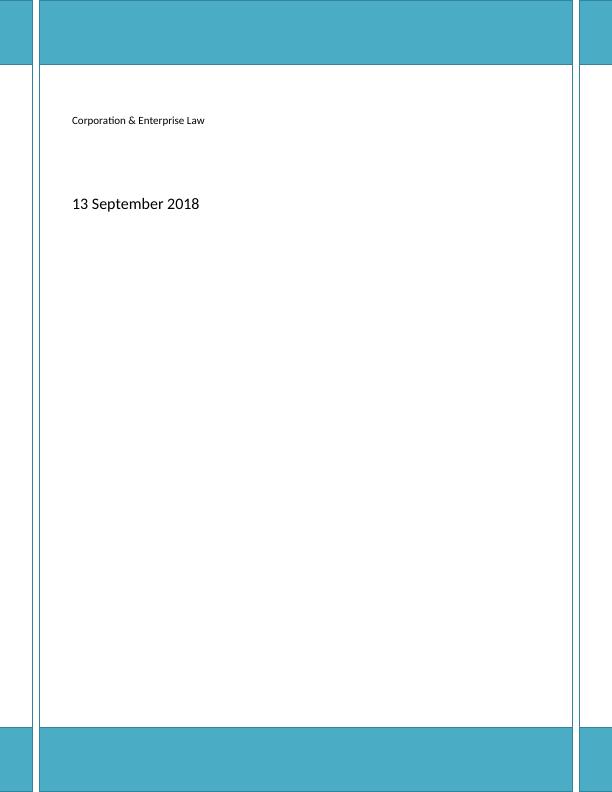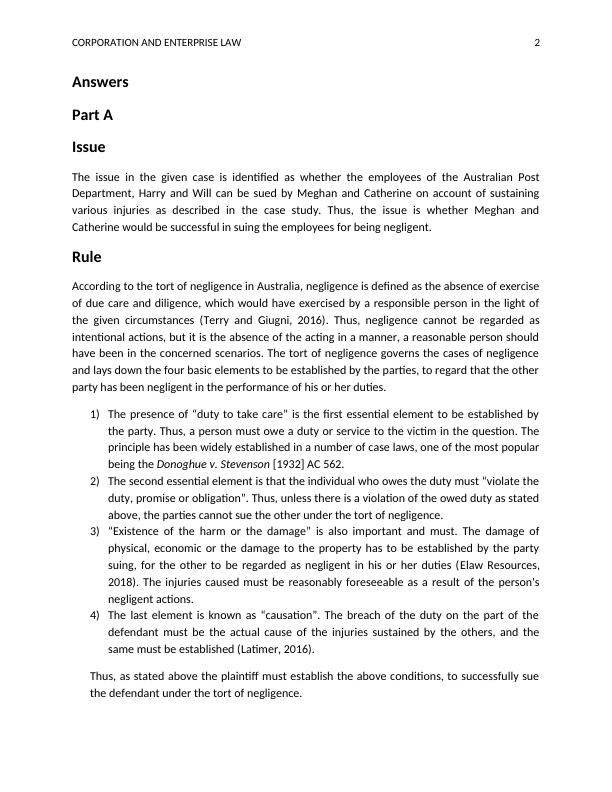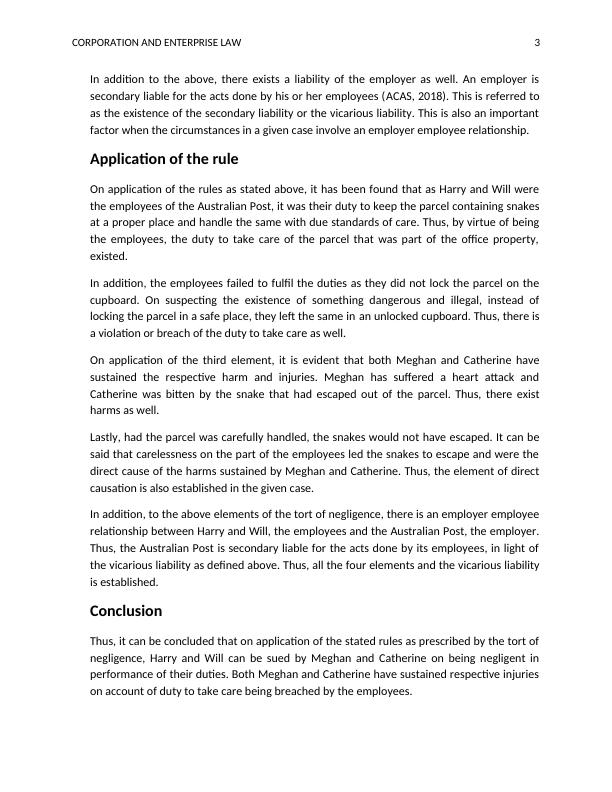Tort of Negligence: Liability of Employees and Employers
Added on 2023-06-07
6 Pages1918 Words148 Views
Corporation & Enterprise Law
13 September 2018
13 September 2018

CORPORATION AND ENTERPRISE LAW 2
Answers
Part A
Issue
The issue in the given case is identified as whether the employees of the Australian Post
Department, Harry and Will can be sued by Meghan and Catherine on account of sustaining
various injuries as described in the case study. Thus, the issue is whether Meghan and
Catherine would be successful in suing the employees for being negligent.
Rule
According to the tort of negligence in Australia, negligence is defined as the absence of exercise
of due care and diligence, which would have exercised by a responsible person in the light of
the given circumstances (Terry and Giugni, 2016). Thus, negligence cannot be regarded as
intentional actions, but it is the absence of the acting in a manner, a reasonable person should
have been in the concerned scenarios. The tort of negligence governs the cases of negligence
and lays down the four basic elements to be established by the parties, to regard that the other
party has been negligent in the performance of his or her duties.
1) The presence of “duty to take care” is the first essential element to be established by
the party. Thus, a person must owe a duty or service to the victim in the question. The
principle has been widely established in a number of case laws, one of the most popular
being the Donoghue v. Stevenson [1932] AC 562.
2) The second essential element is that the individual who owes the duty must “violate the
duty, promise or obligation”. Thus, unless there is a violation of the owed duty as stated
above, the parties cannot sue the other under the tort of negligence.
3) “Existence of the harm or the damage” is also important and must. The damage of
physical, economic or the damage to the property has to be established by the party
suing, for the other to be regarded as negligent in his or her duties (Elaw Resources,
2018). The injuries caused must be reasonably foreseeable as a result of the person's
negligent actions.
4) The last element is known as “causation”. The breach of the duty on the part of the
defendant must be the actual cause of the injuries sustained by the others, and the
same must be established (Latimer, 2016).
Thus, as stated above the plaintiff must establish the above conditions, to successfully sue
the defendant under the tort of negligence.
Answers
Part A
Issue
The issue in the given case is identified as whether the employees of the Australian Post
Department, Harry and Will can be sued by Meghan and Catherine on account of sustaining
various injuries as described in the case study. Thus, the issue is whether Meghan and
Catherine would be successful in suing the employees for being negligent.
Rule
According to the tort of negligence in Australia, negligence is defined as the absence of exercise
of due care and diligence, which would have exercised by a responsible person in the light of
the given circumstances (Terry and Giugni, 2016). Thus, negligence cannot be regarded as
intentional actions, but it is the absence of the acting in a manner, a reasonable person should
have been in the concerned scenarios. The tort of negligence governs the cases of negligence
and lays down the four basic elements to be established by the parties, to regard that the other
party has been negligent in the performance of his or her duties.
1) The presence of “duty to take care” is the first essential element to be established by
the party. Thus, a person must owe a duty or service to the victim in the question. The
principle has been widely established in a number of case laws, one of the most popular
being the Donoghue v. Stevenson [1932] AC 562.
2) The second essential element is that the individual who owes the duty must “violate the
duty, promise or obligation”. Thus, unless there is a violation of the owed duty as stated
above, the parties cannot sue the other under the tort of negligence.
3) “Existence of the harm or the damage” is also important and must. The damage of
physical, economic or the damage to the property has to be established by the party
suing, for the other to be regarded as negligent in his or her duties (Elaw Resources,
2018). The injuries caused must be reasonably foreseeable as a result of the person's
negligent actions.
4) The last element is known as “causation”. The breach of the duty on the part of the
defendant must be the actual cause of the injuries sustained by the others, and the
same must be established (Latimer, 2016).
Thus, as stated above the plaintiff must establish the above conditions, to successfully sue
the defendant under the tort of negligence.

CORPORATION AND ENTERPRISE LAW 3
In addition to the above, there exists a liability of the employer as well. An employer is
secondary liable for the acts done by his or her employees (ACAS, 2018). This is referred to
as the existence of the secondary liability or the vicarious liability. This is also an important
factor when the circumstances in a given case involve an employer employee relationship.
Application of the rule
On application of the rules as stated above, it has been found that as Harry and Will were
the employees of the Australian Post, it was their duty to keep the parcel containing snakes
at a proper place and handle the same with due standards of care. Thus, by virtue of being
the employees, the duty to take care of the parcel that was part of the office property,
existed.
In addition, the employees failed to fulfil the duties as they did not lock the parcel on the
cupboard. On suspecting the existence of something dangerous and illegal, instead of
locking the parcel in a safe place, they left the same in an unlocked cupboard. Thus, there is
a violation or breach of the duty to take care as well.
On application of the third element, it is evident that both Meghan and Catherine have
sustained the respective harm and injuries. Meghan has suffered a heart attack and
Catherine was bitten by the snake that had escaped out of the parcel. Thus, there exist
harms as well.
Lastly, had the parcel was carefully handled, the snakes would not have escaped. It can be
said that carelessness on the part of the employees led the snakes to escape and were the
direct cause of the harms sustained by Meghan and Catherine. Thus, the element of direct
causation is also established in the given case.
In addition, to the above elements of the tort of negligence, there is an employer employee
relationship between Harry and Will, the employees and the Australian Post, the employer.
Thus, the Australian Post is secondary liable for the acts done by its employees, in light of
the vicarious liability as defined above. Thus, all the four elements and the vicarious liability
is established.
Conclusion
Thus, it can be concluded that on application of the stated rules as prescribed by the tort of
negligence, Harry and Will can be sued by Meghan and Catherine on being negligent in
performance of their duties. Both Meghan and Catherine have sustained respective injuries
on account of duty to take care being breached by the employees.
In addition to the above, there exists a liability of the employer as well. An employer is
secondary liable for the acts done by his or her employees (ACAS, 2018). This is referred to
as the existence of the secondary liability or the vicarious liability. This is also an important
factor when the circumstances in a given case involve an employer employee relationship.
Application of the rule
On application of the rules as stated above, it has been found that as Harry and Will were
the employees of the Australian Post, it was their duty to keep the parcel containing snakes
at a proper place and handle the same with due standards of care. Thus, by virtue of being
the employees, the duty to take care of the parcel that was part of the office property,
existed.
In addition, the employees failed to fulfil the duties as they did not lock the parcel on the
cupboard. On suspecting the existence of something dangerous and illegal, instead of
locking the parcel in a safe place, they left the same in an unlocked cupboard. Thus, there is
a violation or breach of the duty to take care as well.
On application of the third element, it is evident that both Meghan and Catherine have
sustained the respective harm and injuries. Meghan has suffered a heart attack and
Catherine was bitten by the snake that had escaped out of the parcel. Thus, there exist
harms as well.
Lastly, had the parcel was carefully handled, the snakes would not have escaped. It can be
said that carelessness on the part of the employees led the snakes to escape and were the
direct cause of the harms sustained by Meghan and Catherine. Thus, the element of direct
causation is also established in the given case.
In addition, to the above elements of the tort of negligence, there is an employer employee
relationship between Harry and Will, the employees and the Australian Post, the employer.
Thus, the Australian Post is secondary liable for the acts done by its employees, in light of
the vicarious liability as defined above. Thus, all the four elements and the vicarious liability
is established.
Conclusion
Thus, it can be concluded that on application of the stated rules as prescribed by the tort of
negligence, Harry and Will can be sued by Meghan and Catherine on being negligent in
performance of their duties. Both Meghan and Catherine have sustained respective injuries
on account of duty to take care being breached by the employees.

End of preview
Want to access all the pages? Upload your documents or become a member.
Related Documents
Can Meghan and Catherine Sue for Negligence in Snake Bite Injuries?lg...
|3
|753
|424
Tort of Negligence: Liability of Australian Post Employees and Financial Adviserlg...
|9
|2002
|417
Business Law Assignment: Tort of Negligencelg...
|8
|1914
|170
Enterprise Law: Negligence and Vicarious Liabilitylg...
|7
|1370
|434
Tort of Negligence in Australia: Elements and Application in a Case Studylg...
|3
|637
|125
Desklib - Online Library for Study Material with Solved Assignments, Essays, Dissertationslg...
|9
|1972
|465
